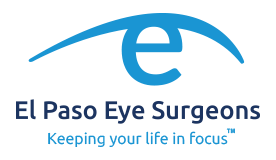Cataracts
Cataracts
A cataract is the lens inside an eye responsible for helping focus light from the outside world onto or close to your retina, which is the tissue that captures the light image like the film of a camera. Over time, this lens – which is clear when humans are born – begins to harden, discolor, and blur vision. The simplest way to describe a cataract is having a dirty or cloudy window inside of the eye(s).
A cataract is surrounded by a clear bag (or capsule), which is connected to the inner wall of the eye by microscopic cables. When performing cataract surgery, we create a small, circular opening in the front part of the capsule—using a special ultrasound probe to turn your cataract into fine, soft pieces and carefully vacuuming our small remnants of the cataract out of the eye.
Because cataracts are responsible for a significant amount of focusing power of the eye, we replace the existing lens with a new prosthetic lens. This new lens helps focus light as close to the retina as possible. Visual clarity depends on how close light focuses to the retina, which is based on the lens power implanted in the eye, similar to the power and prescription of eye glasses.

In the office, while checking for glasses we use your input to determine what power of lens allows you to see clearest–the test where we ask, “which is better one or two?”. Unfortunately, during surgery, we do not have the option of implanting a lens, asking how your vision is and trying different lenses in the eye. Instead, we use specialized machines in our office to take several measurements of your eye, which then calculate the power of the lens needed to minimize your need for glasses as much as possible. The clarity of your vision without glasses will depend on the amount of residual refractive error remaining in the eye. Residual refractive error can occur when the eye has uncorrected astigmatism (special lenses are needed to correct astigmatism), the position in which your lens heals and the accuracy of your lens measurements. Despite using the most advanced and most accurate technology, there are instances where the measured (or estimated) lens power is a little too strong or a little too weak for your eye, leading a patient to remain a little near-sighted or far-sighted (also known as a refractive error). When there is a residual refractive error, glasses may be needed to provide the clearest vision.
There have been some exciting advancements in intraocular lens (IOL) technology over the last decade that can minimize the need for glasses at all ranges of vision. One lens can even be adjusted after surgery to “fine tune” the lens to provide optimal clarity. Lens options are discussed below.
- Your distance vision without glasses is dependent the power of lens we implant and how close light focuses to the retina. The lens power is determined by the machine measurement and patients can still require a small pair of glasses to achieve best vision
- Toric lenses can help reduce the amount of astigmatism your eye has and will provide better distance vision without glasses compared to a monofocal lens, but toric lenses may not correct all astigmatism and a small pair of glasses may be needed to refine your distance vision. A toric lens does not provide any near or intermediate vision and you will need glasses for these activities.
- Multifocal lenses do provide more near and intermediate vision than the monofocal lens, but the technology is still not perfect such that you will be guaranteed to be glasses free. Many still need a small pair of readers for fine print. The distance vision is similar to the monofocal lens, and provides more near and intermediate vision. Also, like the monofocal, some eyes still have a small residual refractive error, and a small pair of distance glasses may be desired or refinement with refractive surgery like LASIK to further minimize the need for glasses.
We hope this helps in your understanding of what your cataract is, how we manage your cataract and what options are available for lens implantation. Should you have any questions, please do not hesitate to contact us so we may address any concerns you may have. Having cataract surgery is elective and is only performed when your cataracts are interfering with your activities of daily life AND when you want it done. Leaving a cataract in place does not harm the eye so if you are happy with your vision you can leave them alone for as long as you desire. If you are bothered by your vision and glasses cannot make you see better, then cataract surgery is our only method for improving your vision (we have to replace that foggy window with a new clear window)
Thank you for taking the time and reading this and remember we are here to answer any questions.
Sincerely,
Mark J Gallardo, MD
Lens Options
Monofocal Intraocular Lens Implant
- Most commonly used lens implant
- Covered by all insurance plans
- Focuses light for one distance only
- For vast majority of patients, lens power is chosen so that distant vision is as clear as possible without glasses; intermediate or near areas are blurred without glasses
- Patients will be fully dependent on glasses for intermediate and near activity
Toric Monofocal Intraocular Lens Implant
- Specialized lens designed to correct astigmatism (It’s important to note that toric lenses do not always correct astigmatism)
- Allows the eye to focus light closer to a single point on the retina, reducing or eliminating the need for glasses
- Good option for someone with astigmatism that wishes to minimize their need for glasses for far/distant vision
Multifocal Intraocular Lens Implant
- Can produce an extended range of vision to include some intermediate and near vision
- Technology splits or shares light as it enters the eye–one third of the light rays are used for distance vision (television/street signs), a third are used for intermediate (computer) and a third used for the near (phone,book, and/or iPad/tablet)
- Provide the best outcome when implanted in both eyes
Small Aperture Lens
- Provides extended depth of focus that improves intermediate and near vision
- Filters out distorted, low quality light and allows high quality light rays to focus on the retina
- Provides a seamless range of vision from distance to near
Light Adjustable Lens
- The power of the lens can be modified after surgery to ensure the clearest vision.
- Has an extended depth of focus providing some intermediate and near vision.
- The lens can be tailored to fit your specific needs.
The More You Know: Cataracts
Cataract Surgery: Fixed vs. Adjustable Lenses
Light Adjustable Lens (English)
Light Adjustable Lens (Spanish)
Cataracts Symptoms and Diagnosis

Vision loss is the most common symptom of cataracts. Typically this occurs very slowly, so patients may not realize they have cataracts until the condition has become advanced. Other symptoms can include:
- Glare
- Halos
- Difficulties with night vision
- Double vision
- Colors appearing less vibrant
Fortunately, cataracts are easy to diagnose. Your doctor may use a standard vision test, or a retinal or slit lamp exam to check your iris, lens, and cornea.
Cataract Surgery
By replacing a compromised crystalline lens with an IOL, your eye surgeon can help you to see more clearly. Depending on the IOL you choose, it may also reduce or eliminate your need for prescription eyewear.
During your surgery, the doctor will first administer a local anesthetic. He will then create a tiny incision, granting access to the lens. Next, ultrasound waves will break the clouded lens into tiny pieces. A special suction device will then vacuum the pieces out of the eye, through the incisions. Your doctor will then place the IOL. Performed on millions of patients every year, the cataract surgery procedure is extremely safe, while the recovery is fast and equally safe. You can expect to return to activity and work soon after surgery. For the first several days after surgery, you will need to avoid strenuous activities, and should use medicated eye drops for several weeks, as instructed by your doctor.
If you have cataract surgery performed on both eyes, your doctor will typically wait several weeks between the procedures. Thanks to advanced technology, patients who have undergone LASIK in the past can undergo cataract surgery without compromising the effects of refractive surgery.
How to Achieve a Smooth Recovery
after Cataract Surgery
after Cataract Surgery
How to Achieve a Smooth Recovery after Cataract Surgery
After cataract surgery, it is common to experience blurry or cloudy vision as well as mild discomfort. It is important to rest for the first few days and avoid putting extra pressure on your eye. With proper care, most side effects should resolve within a week and your eye should be completely healed in one month. The team at El Paso Eye Surgeons in El Paso TX can provide you with detailed instructions to guide you through your cataract surgery recovery. We can recommend steps that will minimize your risk of complications and promote a speedy recovery.
Immediately After Surgery
Though surgery often lasts no more than 15 minutes, you should expect to rest in the recovery area for about 30 minutes to 1 hour for monitoring. You will need to arrange for a ride home, as the effects of anesthesia as well as impaired vision will hinder your ability to drive safely. When you leave the facility, make sure to wear sunglasses with UVA/UVB filters to protect your eyes from bright light.
During the healing period, it is normal for patients to experience:
- Redness
- Blurry or distorted vision
- Itching
- Mild discomfort
Most side effects should subside within a week.
To avoid developing an infection or injuring your eyes after surgery, you should take certain precautions. Make sure to cover your eye with a protective shield for a few days after the procedure. This can help to block irritants such as dust, dirt, bacteria, and debris. You should also avoid rubbing your eyes, and always wash your hands before touching your eyelids or under-eye area. Throughout your recovery, it is important to administer any antibiotic or anti-inflammatory eye drops as directed.
Make sure to wear sunglasses with UVA/UVB filters to protect your eyes from bright light.
Your doctor may prescribe antibiotic or anti-inflammatory eye drops, which can minimize your risk of infection.
Cataract surgery is a safe and effective way to improve eyesight. Almost 90 percent of patients experience a positive outcome and fewer than 2 percent have serious sight-threatening issues. Though rare, post-surgical complications can occur.
Be on the lookout for:
- Vision loss
- Persistent pain
- Bright flashes or floaters
- Excessive redness
If you experience any unusual symptoms, you should contact our staff ass soon as possible to schedule an appointment.

